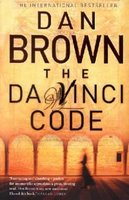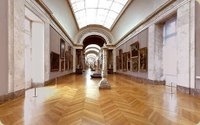The Da Vinci Code

Dan Brown, The Da Vinci Code, 2003, Corgi Books (imprint of Transworld Publishers), London.
Plot: "Murder in the silent after-hour halls of the Louvre museum reveals a sinister plot to uncover a secret that has been protected by a clandestine society since the days of Christ. The victim is a high-ranking agent of this ancient society who, in the moments before his death, manages to leave gruesome clues at the scene that only his granddaughter, noted cryptographer Sophie Neveu, and Robert Langdon, a famed symbologist, can untangle. The duo become both suspects and detectives searching for not only Neveu's grandfather's murderer but also the stunning secret of the ages he was charged to protect [...]."
Jeremy Pugh
@ Amazon
Dan Brown's official Website
The Da Vinci Code as a work of fiction—It was a smooth and flowing
 reading. Dan Brown is gifted with an elegant and clear way of narrating, which offered me, unlike many other readers who devoured the book in two days, the privilege of enjoying it slowly, without rush or thirst of reaching the end. In fact, although abounding of intriguing symbols to decode, surprising turns and elements of suspense as a virtual appendix to each short chapter, Langdon’s long didactic explanations did not leave anything unexplained. Everything was virtually self-contained within each chapter like within the scenes of a script. No wonder why the book is going to be transposed onto a cinematographic set.
reading. Dan Brown is gifted with an elegant and clear way of narrating, which offered me, unlike many other readers who devoured the book in two days, the privilege of enjoying it slowly, without rush or thirst of reaching the end. In fact, although abounding of intriguing symbols to decode, surprising turns and elements of suspense as a virtual appendix to each short chapter, Langdon’s long didactic explanations did not leave anything unexplained. Everything was virtually self-contained within each chapter like within the scenes of a script. No wonder why the book is going to be transposed onto a cinematographic set.I was impressed by Brown's ability of fishing notions of classical disciplines and popular culture (such as visual art, literature, history, ancient languages, semiotics and philology) and ably throwing them on a plate like the ad hoc ingredients of a well-balanced salad. Myriads of codes, symbols and unexpected twists were mingled at art, and were convincing within the scheme of the novel. Nothing was left to the case; everything had a calculated function, a reason, and a double meaning, which was sometimes too easy to discern and, in any case, eventually revealed. For example, while the protagonists were intent in deciphering an enigmatic and mysterious writing, I was sardonically laughing at them, since the enigma was nothing more than a crossword-style puzzle, which did not require any philological expertise, whereas it took them three pages of conjectures to finally reach the point.
 Surprisingly, the action was not the centre of this *detective* story; although the treasure hunt was the absorbing matrix setting the novel into motion, the quest was far too easy. The characters encountered one impediment after the other, but each of them was quickly solved. Only at chapter 85 (out of 105) the situation got more complicated and therefore more entrancing. At the beginning of the novel, there were only two Manichean opponents: the Church, represented by Opus Dei, and the Priory of Sion, represented by Sophie and Langdon. Towards the end of the book, the church, the priory of Sion, the French & English police, the dissident historian, Sophie & Landon are all on the battle field, each with their own personal and clashing reasons to find, or to hide, the grail’s nature and location. The real protagonist of this novel is the woman, but not in psychological terms--all the characters lacked of any personality whatsoever, and Brown was not interested in Sophie and Langdon's romance which he settled in two pages. This book is rather a tribute to the theoretical concept of femininity.
Surprisingly, the action was not the centre of this *detective* story; although the treasure hunt was the absorbing matrix setting the novel into motion, the quest was far too easy. The characters encountered one impediment after the other, but each of them was quickly solved. Only at chapter 85 (out of 105) the situation got more complicated and therefore more entrancing. At the beginning of the novel, there were only two Manichean opponents: the Church, represented by Opus Dei, and the Priory of Sion, represented by Sophie and Langdon. Towards the end of the book, the church, the priory of Sion, the French & English police, the dissident historian, Sophie & Landon are all on the battle field, each with their own personal and clashing reasons to find, or to hide, the grail’s nature and location. The real protagonist of this novel is the woman, but not in psychological terms--all the characters lacked of any personality whatsoever, and Brown was not interested in Sophie and Langdon's romance which he settled in two pages. This book is rather a tribute to the theoretical concept of femininity.
The Da Vinci code as a work of history—The book is full of historical errors and inaccuracies. First of all, the Priory of Sion was founded in the ‘50s as a local movement opposing local gentrification and it is not a secret society preserving shocking revelations about the Christian tradition and History. Secondly, Brown based his novel on the best selling pseudo-historian book Holy blood, holy Grail published in ’82 and presenting a conspiratorial view of western history. The authors have accused Brown of plagiarism.
Well, according to Opus Dei, this book is heretical and a threat to the basis of the Christian faith. Someone could believe to Brown's statement of reality at the beginning of the book declaring the factuality of the event narrated. The factual intent is also double-proved by a theatre-within-the theatre situation: Langdon is the author of a revolutionary manuscript as much as Brown is the author of this contentious novel. It is not a case that Langdon’s editor’s name (Jonas Faukman) is the explicit anagram of Brown’s editor (Jason Kaufman). Of course that statement is part of the fictional agreement between the reader and the author. But, as Umberto Eco points out echoing the cleric fears, this hypothesis of an alter Jesus can be misleading for those "amateur readers" in search of a complot. “Everybody likes complots”— it is self-ironically claimed by Brown through Teabling’s words.
One. To read that many of the theories presented in the book were inspired by some medieval occultist writers and that such ideas were circulating at the time and managed to avoid the rogue surviving the censorship.
Two. The concept of intrinsic net of correspondences, only here presented in a conceptual rather than mystically sensorial way, as Baudelaire describes them in Correspondences. In any way, this sub-link between the pagan and the Christian symbols is not a new discovery and has always pervaded visual arts, literature and popular culture. Even in Tim Burton, Nightmare Before Xmas the Pagan feast of Halloween meets the Christian celebration of Christmas. Instead of finding this connection subversive, I find it charming and somehow mysteriously transcendental.
Photo: George La Tour's Penitent Magdalene





<< Home